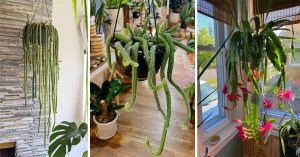The Fishbone cactus! Shaped like the cactus but behaves like the opposite—let’s learn where and how to grow these beauties!
The Fishbone cactus is best if you don’t have enough sunlight in your area. Unlike other cacti, this one is an exception because it can thrive in low-light and moist places. Let’s talk about it in detail!
Fishbone Cactus—Key Facts
| Common Name | Fishbone Cactus or Zig Zag Cactus |
| Scientific Name | Discocactus anguliger /Epiphyllum anguliger |
| Origin | Mexico |
| Dimension | 20-30 cm long and 5 cm wide |
| Indoor/Outdoor | Both |
| Soil | Loose succulent mix with humus |
| Light | Indirect Sunlight |
| Temperature | 60°F to 78°F |
| Watering | Regular Watering |
| Blooming Season | October to January |
| Flowers | White or Off-white |
Fishbone Cactus Information
Discocactus anguliger or the Fishbone cactus is an ornamental epiphytic cactus. It has smooth green skin and an extensive branching system. The round-edged stems are flat and succulent growing 20-30 cm long and 5 cm wide with lobes. The Fishbone cactus also comprises white to off-white flowers with a strong fragrance.
They are endemic to Mexico, in the evergreen forests in Oaxaca, Guerrero, Jalisco Michoacán, and Nayarit. Additionally, it exhibits very fast growth and requires loose soil with humus and moisture in summer. It is best for semi-shade areas with indirect sunlight and the flowers bloom from October to January.
Fishbone cactus looks good in hanging pots or planters for displaying its stunning foliage and beautiful blooms. Plus, medium to large sized pots or planters are great for Fishbone cactus.
Fishbone Cactus Propagation
Fishbone cactus can be propagated with stem cuttings. And as they grow fast so it won’t take long to form a new plant! So you won’t lose your patience as well! Follow these simple steps to propagate your Fishbone cactus.
Gather all the necessary gardening tools like gloves, sharp and sterile cutter, trowel, planter, potting mix, and a sheet or newspaper to make it less messy and more systematic! So, first spread the newspaper to the place where you will work. Then with a sterile sharp cutter take the cuttings from your selected branches and keep them in a cool place.
In the next step, prepare your pot with your potting mix and dab the soil nicely to set it. Pour water and let it drain. After that, carefully set your cuttings in the soil up to 3-4 cm deep and leave it in a bright spot with indirect sunlight.
Lastly, water lightly according to the dryness of the top layer of the soil, and after 2 weeks rooting will start to develop. So, in the meantime give lots of love and attention to your new propagations.
Requirements of Fishbone Cactus
Sunlight
This plant is best suited for indirect sunlight areas and flourishes in its natural environment. And if grown indoors then a bright spot is perfect for it.
Soil
Always remember that it is an epiphyte. So, mostly it enjoys mossy or orchid bark mix as a potting mixture. However, you can add this orchid mix with a well-drained, loose soil potting mixture and see the magic. To make the soil loose and well-draining add perlite to your potting mixture.
Water
Again in comparison to other cacti, this plant enjoys regular watering. However,, there are some tips to follow. At some point, if there is a gap in regular watering then check the top layer of the soil, and if it is completely dry then only you can water it. But, kindly avoid watering it with cold water because the roots may go into shock!
They are actually super sensitive to hard tap water and other chemicals in it so they prefer clean filtered water. Lastly, rainwater can also do wonders for this plant!
Temperature
They can grow healthy and enjoy the tropical environment with humid conditions. The range of temperature favorable for it is around 65°F to 80°F.
Fishbone Cactus Care
Fertilizer
Fertilization is required during the active growing seasons of spring and summer. For organic fertilization, you can use dried cow dung, husks, and vermicompost in small amounts.
And again there are many other fertilizers available in the market with different NPK ratios, you can go with an NPK ratio of 10-10-10.
Pruning
Fishbone Cactus don’t require regular pruning for their healthy growth and development. However, to keep it tidy you can trim the stems from time to time and these trimmed stems can also be used to propagate new plants.
Pest and Disease
As it loves humid and tropical conditions so it is susceptible to pests and diseases. Common pests are mealybugs, fungus, aphids, glasshouse red spider mites, and so on. To deal with pests keep a neem oil or eucalyptus oil spray always handy.
Lastly, make sure that after spraying these pesticides keep your plant in the shade and not under sunlight or else the plant will suffer burns and die.
Bonus Tips!

- Always keep an eye on the growth of your Fishbone cactus. If you see the growth is leggy or unhealthy try to move it to a brighter area or near the window if indoors.
- Again, this plant is very susceptible to infections, so if you see brown spots on the leaves you know it is a fungal infection. There is only one thing you can do when this happens, cut the affected leaves or stems and then spray neem oil at night or evening. Place the plant in a shady spot and then move it back to a brighter spot after 2-3 days.
- Wrinkled leaves indicate that your Fishbone cactus needs more water so water accordingly.
Now, we hope that with this information, you can grow a Fishbone cactus without any hesitation. Let us know in the comments section for any additional information regarding this unique cactus.












